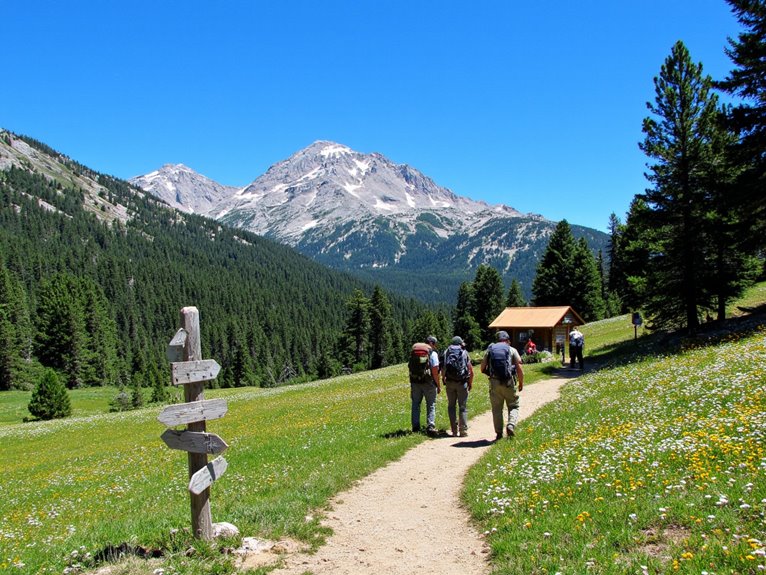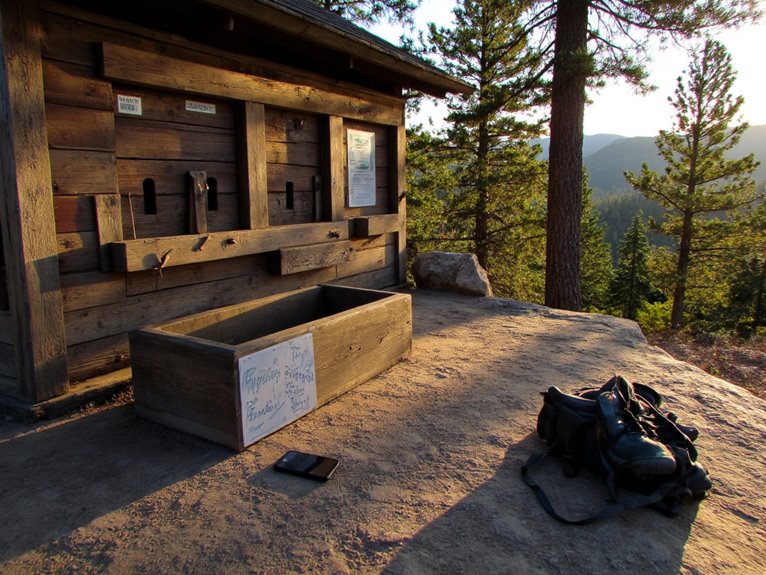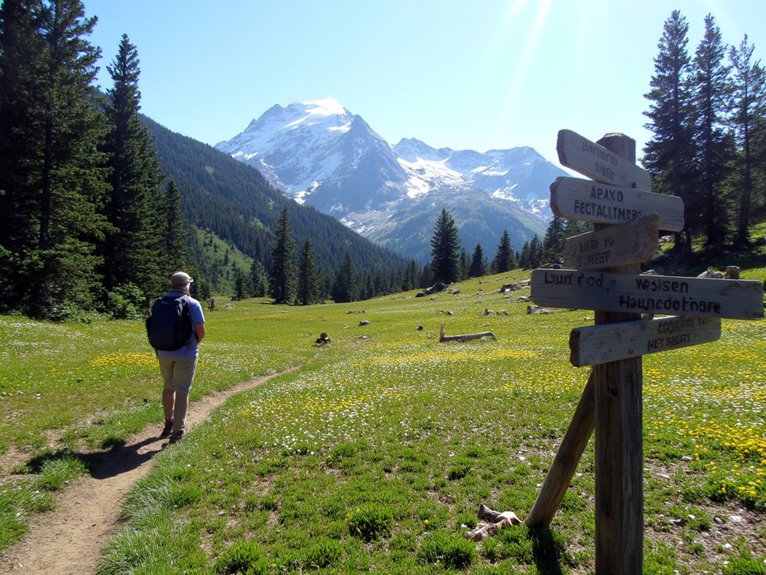Understanding Wilderness Permit Systems: Quotas and Reservations
Wilderness permit systems use quotas to balance environmental protection with public access, limiting daily entries to as few as 12 people per trailhead during peak seasons. You’ll need to navigate Recreation.gov’s booking platform, where 60% of permits release six months in advance and the remaining 40% become available seven days prior. These systems enforce strict group sizes, designated camping areas, and non-transferable reservations to maintain quota integrity and preserve wilderness solitude for future visitors.
We are supported by our audience. When you purchase through links on our site, we may earn an affiliate commission, at no extra cost for you. Learn more. Last update on 13th November 2025 / Images from Amazon Product Advertising API.
Notable Insights
- Wilderness permits balance environmental protection with public access by regulating visitor numbers and preventing habitat degradation.
- Quota systems allocate permits through timed releases, typically 60% available months ahead and 40% one week prior.
- Recreation.gov serves as the primary platform, with systems like Yosemite using 24-week advance windows and weekly lotteries.
- Permit holders must follow strict regulations including group size limits, designated camping areas, and fixed entry dates.
- Cancellation policies protect investments while no-show deadlines and non-transferable permits maintain quota system integrity.
Wilderness Permit Requirements and Their Purpose
When you plan to explore America’s designated wilderness areas, you’ll encounter permit systems designed to balance human access with environmental protection. These requirements serve five primary functions in wilderness management.
Permits regulate foot traffic to prevent erosion and habitat degradation in fragile ecosystems. They preserve solitude opportunities by controlling visitor density during peak seasons. The systems guarantee compliance with the Wilderness Act of 1964, maintaining sustainable resource use standards.
Wilderness access operates through equitable distribution methods including advance reservations, lottery systems, and limited walk-up availability. This approach balances high demand with ecological preservation needs. Many wilderness areas offer free permits or charge only minimal fees to maintain accessibility for outdoor enthusiasts.
Permits enable agencies to monitor visitor impact and enforce regulations effectively. The system facilitates scientific research and land management goals while reducing search and rescue incidents in overcrowded areas.
How Quota Systems Control Access During Peak Seasons

Peak season demand creates intense competition for wilderness permits, requiring sophisticated quota systems that distribute access fairly while protecting natural resources. These systems regulate visitor behavior through strategic allocation methods that balance accessibility with environmental protection.
Quota fairness depends on timing and methodology. Most parks use pre-allocated systems—Inyo National Forest and Yosemite release 60% of permits six months early, holding 40% for two-week releases. This creates multiple access opportunities.
Here’s how quota systems maximize effectiveness during peak periods:
- Staggered release windows spread demand across different booking periods
- Dynamic adjustments respond to real-time visitor pressure and ecosystem conditions
- Entry point distribution spreads users across multiple trailheads
- Immediate permit recycling returns cancelled reservations within 24 hours
These mechanisms prevent overcrowding while maintaining democratic access principles.
Online Reservation Processes and Timing

Once quota systems establish the framework for wilderness access, you’ll navigate the actual reservation process through centralized online platforms that demand precise timing and strategic planning.
Recreation.gov serves as the primary portal for most national parks, requiring account creation before booking. Yosemite operates on a 24-week advance window with weekly lottery cycles running Sunday through Saturday. Winners receive notification by Monday evening and must confirm by Thursday 11:59 p.m.
The remaining 40% of permits release exactly seven days prior at 7 a.m. Pacific Time, with popular trailheads filling within minutes. Effective online reservation strategies include submitting eight preferred itineraries per application and maintaining flexibility with dates.
Peak season considerations require immediate action during release windows, as high-demand locations sell out rapidly.
Permit Regulations and Travel Restrictions
Securing your wilderness permit represents just the beginning of maneuvering a complex web of regulations that govern every aspect of your backcountry experience.
Getting that wilderness permit is only your first step into a maze of strict backcountry rules and regulations.
Permit holder responsibilities extend far beyond simply booking your dates, requiring strict adherence to entry schedules and designated group leadership protocols.
Group size limitations directly impact your trip planning, with most wilderness areas enforcing strict campsite capacity constraints.
Large groups must split into separate units, traveling and camping independently to comply with environmental protection standards.
Many parks now implement timed entry systems during peak seasons, requiring visitors to reserve specific time slots for park access.
Key regulatory requirements include:
- Fixed entry dates – No delays or extensions permitted beyond your designated start date
- Maximum stay limits – Specific time restrictions prevent long-term campsite occupation
- Designated camping areas – Camping restricted to approved sites, avoiding water sources and sensitive habitats
- Road access verification – Trailhead accessibility depends on seasonal closures and construction schedules
Cancellation Policies and Quota Management
While permit acquisition marks the start of your wilderness journey, understanding cancellation policies and quota management systems becomes essential for both protecting your investment and accessing last-minute opportunities.
BWCA’s 2025 cancellation impact reached 11,244 permits, demonstrating significant effects on quota flexibility. Wilderness areas typically enforce strict no-show deadlines—you must print permits by 10 a.m. on entry day or face automatic cancellation. This system quickly releases unused permits back into available quotas.
| Release Phase | Timing | Quota Percentage | Update Frequency | Availability Status |
|---|---|---|---|---|
| Primary | 6 months prior | 60% | Real-time | Standard booking |
| Secondary | 2 weeks prior | 40% | Within 24 hours | Last-minute access |
| Cancellation | Variable | As available | Within 24 hours | Released permits |
| No-show | Entry day 10am | Individual | Immediate | Same-day release |
| Emergency | Variable | Individual | Real-time | Rare exceptions |
Permits remain non-transferable, preventing resale while maintaining quota integrity.
Frequently Asked Questions
What Is the Cost of Wilderness Permits for Different Areas and Group Sizes?
Wilderness permit pricing varies considerably by location and structure.
You’ll pay $2-5 for day use permits in areas like Desolation Wilderness, while overnight permits typically cost $5 per person.
Everglades charges a $21 non-refundable reservation fee plus $2 per person nightly.
Group fees depend on size limits—most parks cap standard groups at 4-8 people.
Larger groups face additional restrictions and higher costs through special permit requirements.
Can I Get a Refund if Weather Forces Me to Cancel My Trip?
Weather-related refund policies vary greatly between wilderness permit systems and outfitters.
Most don’t guarantee refunds for weather cancellations alone. Cancellation fees increase as your departure date approaches—you’ll typically get partial refunds if you cancel 70+ days ahead, but nothing within 30 days.
Administrative fees like Recreation.gov’s $6 reservation charge aren’t refundable.
Purchase trip insurance to protect against weather-related losses and associated penalties.
Are Children Counted Toward Group Size Limits and Do They Need Permits?
Yes, children of all ages count toward group size limits regardless of children’s age considerations.
You don’t need separate permits for kids—one permit covers your entire party.
However, permit age requirements still include children in total group calculations.
While children under 12 may qualify for free permits, they’re counted toward maximum party sizes, which typically range from 5-10 people depending on the wilderness area.
What Happens if I Encounter an Emergency and Need to Exit Wilderness Early?
You’re required to notify wilderness management when emergency procedures force early exit.
Contact park authorities with your permit details, exit location, and incident specifics. This prevents unnecessary search operations if you’re overdue.
For wilderness evacuation involving external rescue, provide exact coordinates and group status to emergency responders.
Document the emergency timing and nature for official reports.
Some areas mandate formal permit cancellation notifications.
Can I Modify My Itinerary or Extend My Trip After Receiving a Permit?
Itinerary changes after receiving your permit are extremely limited and require direct communication with park staff via email.
Modifications aren’t guaranteed and depend on quota availability.
You can’t change permit holder names, group size, or key details after submission.
Trip extensions beyond your permitted exit date generally aren’t allowed without prior approval and a new permit, which may be impossible due to quotas.
On a final note
You’ll need to plan ahead for wilderness permits. Quotas exist for ecosystem protection and visitor safety during peak seasons. Most reservations open exactly 180 days before your planned entry date at 10:00 AM Pacific Time. You must follow designated routes, group size limits, and campfire restrictions. Cancellation deadlines vary by agency—typically 7-14 days before entry. Check specific wilderness regulations since permit systems differ greatly between managing agencies and locations.




